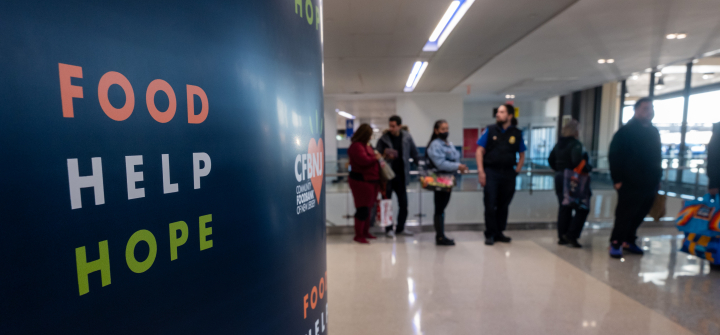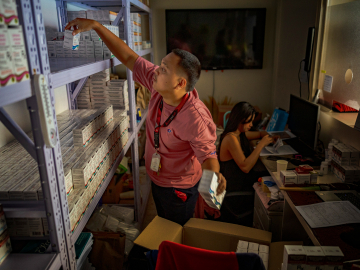The U.S. Is Choosing to Fly Blind on Hunger
Parke Wilde, a food economist, remembers visiting a call center in Maryland in the late 1990s. A few dozen callers sat in rows, dialing up Americans across the country to see how they were doing, food-wise.
The interviewers “were asking people these very poignant questions about what’s going on in their lives. ‘Did you worry? Did your food not last? Did you lose weight because of not having enough money for food?’” recalls Wilde, a professor at the Friedman School of Nutrition Science and Policy at Tufts University.
For the past thirty years, the answers to the 18-question Household Food Security Survey have formed the foundation of the USDA’s annual Household Food Security Report, which has tracked hunger and food insecurity by surveying Americans about whether, and how much, they struggle to get enough to eat. For policymakers, anti-hunger advocates, and researchers, the data is a key tool to assess and adapt nutrition programs and ensure federal funds are well-spent.
“It’s one of a handful of key statistics that tells us how we’re doing”—along with poverty rates and unemployment, making it a key economic indicator that has long had bipartisan support, Wilde says. But not for much longer.
In September, the USDA announced that it would discontinue the survey and corresponding report, calling it “redundant, costly, politicized, and extraneous.” Amid the government shutdown, the final report, for 2024, did not go out as planned on October 22.
Researchers and anti-hunger organizations say the move jeopardizes the country’s chances at ending hunger as Americans contend with rising food prices, tighter work requirements for food aid, and the government shutdown, which could lead to the first halt to food stamp payments in living memory, on November 1.
A Snapshot of American Hunger
The USDA hunger report data offers the only continuous, nationally representative data on hunger in the U.S.—including national and state-level trends and subgroups like seniors or people with disabilities.
The data helps inform, evaluate, and adapt federal food assistance programs like the Supplemental Nutrition Assistance Program (SNAP)—relied on by nearly 42 million Americans—and the Women, Infants, and Children’s Program (WIC), the food stamp program for women and children.
“There’s no other data set in the United States where this has been consistently assessed for over 30 years—and we’re going to be losing that,” says Craig Gundersen, an economics professor at Baylor University and a leading researcher on the causes and consequences of food insecurity.
The data also support clinical and emergency applications—for example, screening patients for hunger or targeting disaster response efforts—and provide a benchmark for evaluating the quality of other hunger studies.
Attack on SNAP
In a press release announcing the end of the survey, the Trump administration highlighted that food insecurity “has not improved while SNAP spending has increased 87% from 2019–2023.”
Those figures are “accurate but irrelevant” to the question of whether to keep gathering the data and miss the nuances of what’s really driving food insecurity, says Gundersen.
He maintains that the cost of food—not poor program design—has driven spikes in food insecurity. For example, Gundersen’s research showed a 35% decline in food insecurity between 2010 and 2021, with marked improvements amid pandemic-era safety net programs—but not evenly across all groups. Then food insecurity rates rose in 2022 and 2023, “100% due to inflation. Food prices hurt low-income families the most.”
Meanwhile, expanded SNAP work requirements set to take effect November 1 are projected to cut off food stamps for 2.4 million Americans, according to a Congressional Budget Office analysis released in August.
Nixing the report stands to undercut the government and researchers’ ability to evaluate the impact of that decision—and any others related to federal food policy.
Research projects that use the survey data to evaluate food security alongside economic trends are “a key part of making sure that the large taxpayer investment [in these programs] is justified,” says Wilde.
Beyond measuring hunger alone, the survey provides a reliable measure of how households, especially low-income households, are doing with the boom and bust of the economic cycle, or with changes in government policy and safety net programs, Wilde says.
“Food insecurity isn’t just about not having enough food—it’s about not having enough income because the economy isn’t functioning in a way that’s supportive,” says Sonia Angell, a professor of the practice of American Health at the Johns Hopkins Bloomberg School of Public Health. “Without this data, we can’t make these programs better.”
For example, the survey played a key role in showing that the temporarily expanded child tax credit cut childhood poverty rates nearly in half, according to Feeding America, an anti-hunger organization that relies on the USDA data to assess need and deploy resources.
While addressing rising demand amid threats to federal food aid, Feeding America is also seeking new ways to gather the USDA data by “exploring innovative ways to measure food access,” according to a statement. That includes working with food banks in Arkansas to study statewide food needs, and in California’s Bay Area to refine local food insecurity data. But these individual efforts cannot replace the massive scale of the USDA hunger survey, which was designed to paint a comprehensive picture of American food insecurity.
Legacy of Bipartisan Support
The hunger report was launched in 1996 to fill a void in the country’s understanding of hunger.
“Before 1996, we really had no idea what the extent of food insecurity was, or whether food assistance programs were working”—only sporadic, single-question surveys, Gundersen says.
To fill that gap, the Household Food Security Survey was developed and included in the Current Population Survey (CPS).
From the start, the data drove the country’s goals on hunger. Its very first results revealed that some 12% of U.S. households were food insecure—and informed a bipartisan commitment to reduce that figure by half, to 6%, by 2010.
Despite some improvements over the years since, that goal has not been met—and 13.5% of U.S. households struggled to get food on the table at some point in 2023, up from 12.8% in 2022. Still, that ambitious 6% goal was a reflection that the government, regardless of party affiliation, took an interest in how American households were faring, says Wilde.
“Sometimes it seems the United States has given up on those older goals,” Wilde says—but he maintains, “Cutting the prevalence of food insecurity by half remains feasible today.”
But no matter the chosen route to getting there—be it labor market incentives and wage growth, or a strong social safety net and adequate SNAP benefits—national hunger data is essential and “genuinely bipartisan,” Wilde says.
He hopes—and expects—that will soon be impossible to deny.
“We may have a gap of a year … and then a sense of regret that’s probably going to be bipartisan,” says Wilde. “I would be surprised if it’s not essential in the long run to know how many households are food insecure and hungry.”
Join the 50,000+ subscribers in 170+ countries who rely on Global Health NOW summaries and exclusive articles for the latest public health news. Sign up for our free weekday newsletter, and please share the link with friends and colleagues: https://www.globalhealthnow.org/subscribe.
Federal workers impacted by the government shutdown, including TSA officers and air-traffic controllers, line up to receive food parcels at Newark Liberty International Airport, in New Jersey, on October 27, 2025. Spencer Platt/Getty Images





